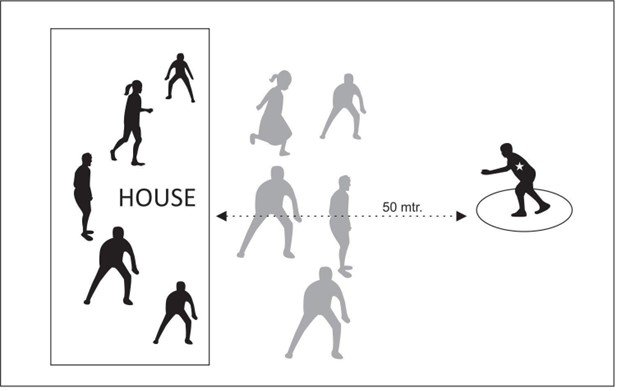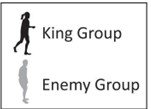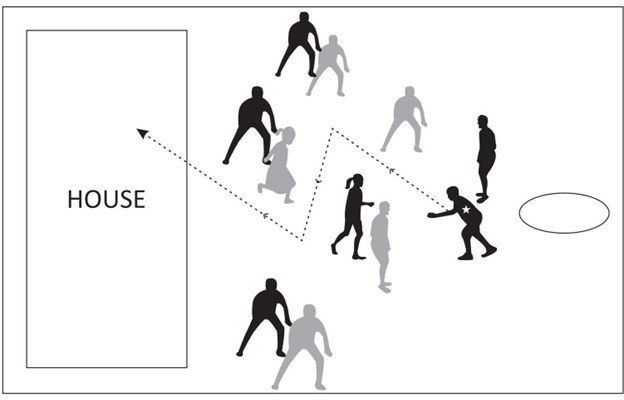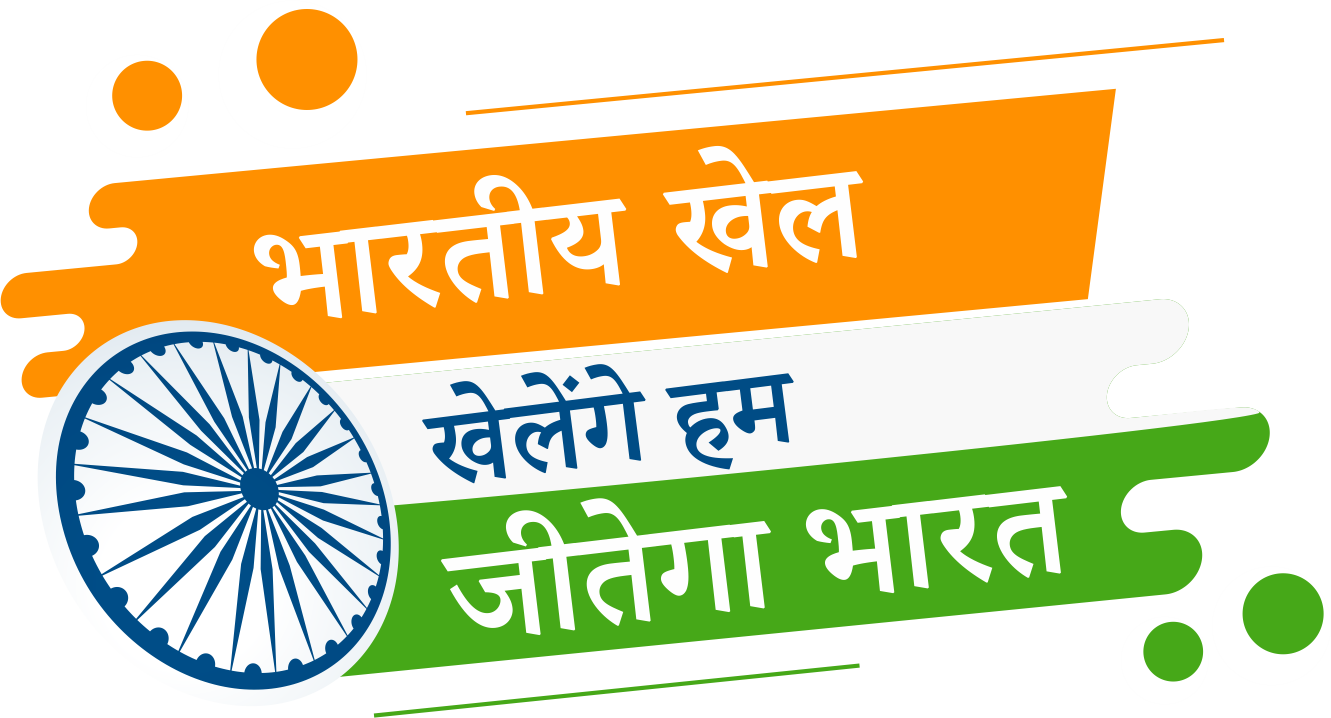Gella Chutt
सीता उद्धार | বাউচি | മണ്ഡി കുഞ്ജു | Prisoner’s Base | Dare Base
Introduction
Gella chutt is an outdoor team game of Tripura, India, once widely popular in north-east India. Played by two groups, the king group and the enemy group, it is a form of run-and-chase game. The objective is to save the king from prison and aid that player to reach his house. The king’s move from the prison to the house is called gella chutt, which translates to ‘the king ran away’.
The king’s group, called rakshak, attempts to free the king by sending a team member to the prison to rescue the king, without being captured by a member of the opposing team. The enemy group is called shatru. Shatru players scatter all around the prison to prevent the king’s escape. The rakshaks focus on the king’s moves. They save him or her from the enemy by forming a fence around the king and moving ahead quickly while tagging out the enemies.
Other Names
| Bihar, Uttar Pradesh | Seeta uddhar |
| Kerala | Mandi kunju |
| USA | Darebase |
| Punjab | Budhi basanti |
| West Bengal | Budhi kapati, bau-basanti, budir chu, bauchi |
| Medieval Europe | Prisoner’s base |
The Play
The game’s objective is for the player of the rakshak group to take the king to the house from the circular court marked as the prison. They must pass through an area in which the opponents (enemies) are scattered to catch the king and the defenders. If the king makes it to the house, then the rakshaks earn a point. If any shatru touches the king, then the king is declared dead. The teams then interchange roles to play the next round. With a lot of players running, this game is lively and exciting at all times.
Number of Players and Key Roles
The game is played by two teams: the king group and the enemy group. The number of players in each group is around seven to nine. The number of participants in the game may differ depending on the size of the playing area and the number of available players. From the defending group, a player—generally the strongest one—is selected as the king. This player is crucial as the play revolves around saving or catching the king.
Playground
This game requires two regions in the playground, 50 m apart. As shown in Fig. 13.1, there is one rectangular region on the left and a circular one called the prison on the right. The sizes of the courts can be drawn as per the number of players in a team. Typically, the prison is about 2 m in diameter, and the house is about 5 m x 2 m. The house should accommodate all the rakshaks except the king. The external boundary of the play area is about 60 m x 30 m, but the area can be reduced or enlarged based on the availability of space and the number of players.
Equipment Needed
Chalk sticks or lime powder is required to mark the boundaries of the play area.


Position of the Players at the Beginning
Playing Method
- From the rakshaks, one player is designated as the king. The king takes a position in the circle marked as the prison. The people stay in the house, in the large box on the left.
- The king aims to escape from the prison and rush to the house without being touched by a shatru. The shatrus spread out to stop the king from reaching the house.
- The game starts when the rakshaks run one by one towards the prison shouting ‘Kut, kut.’ The rakshak team forms a chain by joining hands to safeguard the king while he or she is escaping from prison and also to tag opponents who come in their way.
- If a shatru is touched by a rakshak, then both the players are declared out and take no further part in the game. Therefore, both sides avoid touching each other.
- Rakshaks are permitted to go inside the prison and make a human chain. A player declared out can no longer participate in the game. Thus, the rakshaks keep the shatrus at bay while the king tries to find a way to outwit the enemies and reach the house safely.
- As soon as the king moves out of the prison cell, the shatrus rush to touch him or her. If they are successful, the king is declared dead. The game continues with the groups exchanging roles.
- If the king reaches the house safely, the king’s team (rakshaks) gets a point. The team’s roles change, and the shatru team now plays the king and his rakshaks.
- The rakshaks get only five chances to send the defenders for the king’s rescue. After that, they lose the opportunity to save the king, and the game continues with a reversal of roles.
- The rakshaks can score maximum 10 points at a stretch. After that, they take the role of the enemy group.

Players in action with the King shown with a Star.
Rules
- If any team member touches the opposing team members other than the king, then both members are out of the game. These players can enter the game only in the next round after the next king is selected.
- If a shatru touches the king, then the king is considered dead, and the rakshaks lose against the enemy. Now the enemy group plays as the king and rakshaks.
- If rakshaks attempting to rescue the king make it through the opposing team from house to prison without being caught, they are safe while in the prison and can pick their own time to run with the king back to their side of the line.
- Only touching with the hand is allowed. Using force or holding players is not allowed.
- The shatrus cannot enter the prison or the house. Also, they cannot touch the players who are safe in the house or who have reached the prison and are with the king.
- Two enemies cannot chase the defenders at a time and vice versa.
- If any shatru steps outside the boundary line during the chase, then that player is out.
- A team can collect maximum 10 points at a stretch, and after that, the other team will get a chance to be the rakshaks.
- If any rakshak reaches the prison, he or she can take shelter in the prison with the king, and the king can wait for an opportunity to return to the house any time. In case the player is unable to return to the house but the king has reached, then the player is out of the game. To revive and take the player for the rest of the game, the team can sacrifice one point they collected.
- To pause the play, the team or any player can ask the captain for a 2-minute break. During the break, the king cannot return to the house. This break cannot be taken during any chase or action.
Scoring
- The rakshaks get two points for each time the king safely reaches the house.
- If the enemy group touches the king, he or she is considered dead. Then the enemy group will get one point.
- The game can continue for three rounds or for a decided time. In the end, the total points of both the teams are compared to declare the winning team. In many informal games, though, no score is recorded.
Positions, Tasks and Techniques
| Roles | Positions | Tasks | Strategy | Techniques |
| King | Take a position in prison. | Attempt to escape the prison and reach the house with the support of the rakshaks. | Do not leave the prison until some of the teammates come to guard and support in escaping. The king is the key player, and therefore, staying alive is the primary objective while escaping. |
| Rakshaks | At the start, take a position in the house. | Run towards the prison, one by one, to support the king’s escape and guard the king from tagging by the shatru group. | Focus on the king’s moves and save him or her from the shatru by forming a fence. Move ahead quickly while tagging out the enemies. |
| Shatrus | Surround the prison and scatter in the field. | Follow the rakshaks moving towards the prison, tag them out and keep a watch to instantly tag the king if he or she leaves the prison. | Try to divert the attention of the players guarding the king and separate them from the king. |
Key Skills Required
Fast running, quick decision making and vigilance are preferred skills for the participants. The player selected as the king is at the centre of the game, so that player needs to be strong, swift and more alert to be on the winning side. The game engages the players in a series of feints and dares.
Gella chutt is ideal for a big group of players and with large open spaces as playfields. Players aged between eight to fifteen can play this game on the grounds near their houses or even on the streets. The game is running and chasing, and no specific skill or training is essential to begin playing.
Caution
The game involves speed and zigzag running, so the playground should be even-surfaced and dry to avoid any injury from stumbling.
Though unnecessary in casual games, it is advisable to draw an outer boundary of the playing area to avoid unnecessary arguments if some players run far away. You may assign some trees, buildings or a road as the end of the playground.
Skills Developed
The game allows for vigorous exercise, judgement of movements and risk-taking. It develops the running speed of players, logical thinking and cooperative strategy-building.
Life Lessons
The game develops decision-making ability, keeping the team objective as the primary goal. The players may be in a dilemma because they have to choose between self-safety and common interest. At times, in the game, if they choose to act in self-interest, it may push the team to a loss. We sometimes face this situation in the course of life, and the experience gained in the game can be helpful to make the right decisions. An article on the website PsycholoGenie furnishes the meaning of this concept along with examples.
Current State
The game has lost its popularity in India now. In the villages of Tripura and Uttar Pradesh, however, we may find children enjoying this game.
The game is also known as Dare Base in Western countries. In F. Anstey‘s comic novel Vice Versa (1882), the boys at Dr Grimstone’s boarding school are required to play a game called ‘chevy’ and said to be commonly known as a prisoners’ base.
Dare Base was the original title of the 1952 Nero Wolfe mystery novel Prisoner’s Base by Rex Stout (1886–1975). The plot clearly references the game.
Variations of the game
Budi Basanti or Seeta Udhaar /Bauchi (The Old Lady)
Instead of the king in prison, the key player is Seeta who is captured and kept in Lanka and guarded by demons. The other players of the team are in the big circle, and their goal is to rescue Seeta from captivity, just like we discussed rescuing the king. The chief variation is the rakshaks holding their breath like in kabaddi, when they go to Lanka and back to Ayodhya.
Glossary
Gella The king
Chutt Ran away/escaped
Address
Bharatiya Khel
Indian Knowledge Systems (IKS) Division
Ministry of Education (MoE),
Government of India,
Our office is located in
All India Council for Technical Education (AICTE)
Nelson Mandela Marg,
Vasant Kunj,
New Delhi-110070

